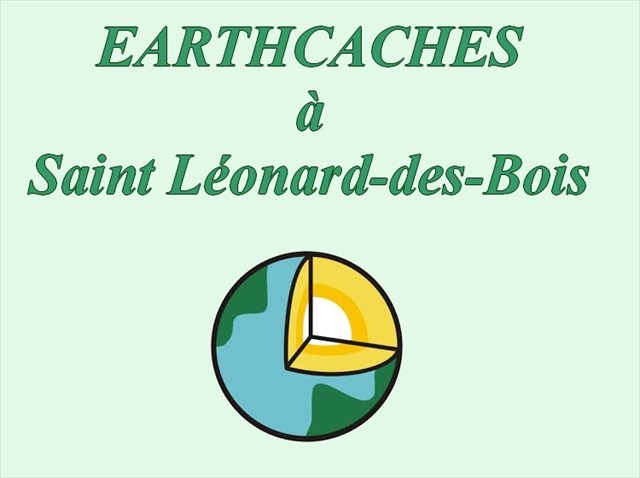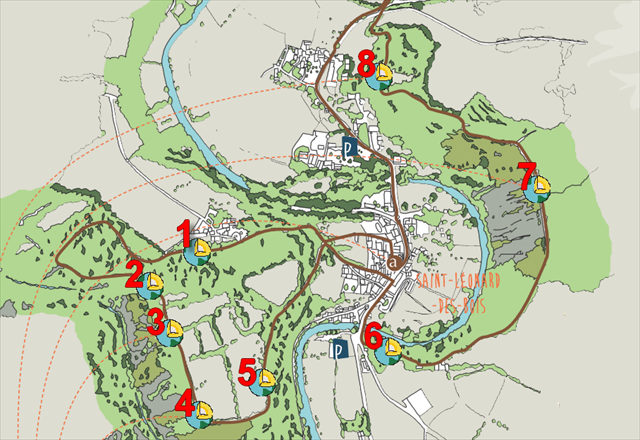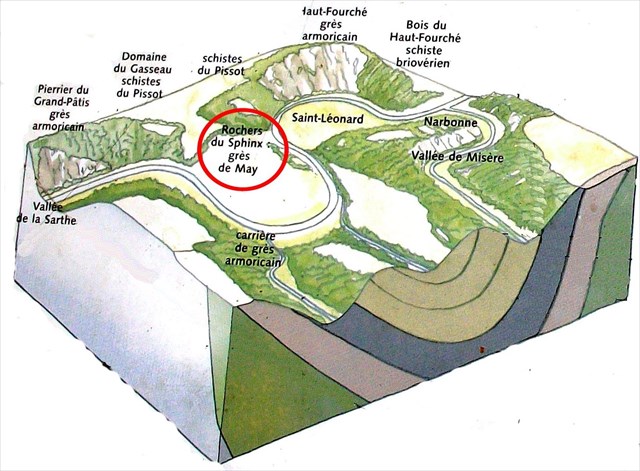
|
 |

|
Cette série de 8 earthcachesest située sur le sentier intitulé "Histoires Géologiques". Chaque earthcache se trouve à l'emplacement d'un panneau informatif. Ce parcours vous permet de retracer 600 millions d'années d'histoire qui ont formé les roches et façonné le paysage. Le circuit, long de 10 kilomètres(3 heures environ), avec de forts dénivelés, est balisé et fléché en brun.
ATTENTION! Le parcours est fléché dans un seul sens, à l'inverse des aiguilles d'une montre. Les parkings et le point de départ du sentier sont indiqués en waypoints additionnels.
|
This series of 8 Earthcaches is on the trail entitled "Geological Stories". Each earthcache is located in the vicinity of an information board. This tour allows you to trace 600 million years of a history of geological events that formed the rocks and shaped the landscape. The circuit, 10 kilometers long (about 3 hours), with steep climbs, is marked and signposted in brown.
WATCH OUT! The tour is signposted in one direction, anticlockwise. Car parks and the starting point of the trail are in additional waypoints.
|
 |
Les montagnes se forment suite à la collision de deux plaques tectoniques: une partie de la croûte terrestre est poussée vers le haut sous l'effet de la compression. Les roches profondément enfouies (de 3000 à 6000 m), chauffées à une température relativement élevée (200 à 300° env.), sont relativement ductiles (malléables): elles peuvent alors se déformer sans trop se casser: c'est le plissement. Il engendre une succession de plis surmontés par la couche géologique la plus récente, les anticlinaux formant une voûte vers le haut et les synclinaux formant un fond de bateau vers le bas, comme celui de Saint Léonard-des-Bois.
Ces processus peuvent produire des plis de quelques millimètres à plusieurs kilomètres de long. Le synclinal de Saint Léonard-des-Bois est dit "ordovicien" parce que le grès de May, la couche la plus récente du pli, date de l'Ordovicien (env. -460 Ma). Les roches se sont plissées lors de la formation de la chaîne hercynienne , vers -320 Ma.
Les grès sont très durs, ils résistent mieux à l'érosion que les schistes. Dans les Alpes Mancelles, ils constituent les crêtes et les reliefs. Les Rochers du Sphinx (leur silhouette évoque le Sphinx de Gizeh en Égypte) qui se dressent devant nous sont constitués de grès de May dégagé par l'érosion. Leur forme en "coque de bateau" est caractéristique d'un pli synclinal. À leur pied affleurent les schistes du Pissot qui ont été plus érodés que les grès. |
|
 |
|
Mountains form as a result of the gradual powerful collision of two tectonic plates. Part of the earth's crust is pushed up under the effect of compression. Rocks that are deeply embedded in the earth (from 3,000 to 6,000 metres down) and heated to a relatively high temperature (about 200 to 300°C) become malleable. Rock can then change shape without necessarily breaking: this is known as folding. A succession of folds may occur, covered by the most recent geological layer: anticlines form a vault near the high point , with a syncline the shape of an upturned boat's hull towards the base. An example of a syncline is found at Saint Léonard-des-Bois.
These processes can produce folds from just a few millimetres to several kilometres in length. The Saint Léonard-des-Bois syncline is said to be "Ordovician" because the May sandstone, the most recent layer of rock in the fold, dates from the Ordovician (about 460 million years ago). The rock was folded when the Hercynian chain was formed about 320 million years ago.
Sandstone is very hard and more resistant to erosion than shale. In the Alpes Mancelles, sandstone makes up the crests and the relief. The rock of the Sphinx (in so-called because its silhouette looks like the Sphinx of Giza in Egypt) that stands facing us is made of May sandstone that has been exposed by erosion. The boat-hull shape is typical of a synclinal fold. At its base are Pissot shale outcrops that have eroded more than the sandstone. |
Comment valider votre visite !
Allez aux coordonnées indiquées au début de ce descriptif. Vous trouverez un panneau d'information.
Afin de valider votre visite, vous devez répondre aux questions suivantes:
1) Sur le schéma, quel type de roche est représenté par une couche de couleur gris foncé?
2) Pourquoi les Alpes Mancelles ne sont-elles pas considérées comme des montagnes?
3) Sur la droite du panneau, un échantillon de roche est exposé. De quel type de roche s'agit-il?
Facultatif: prenez une photo de vous et votre GPS avec le rocher du Sphinx en arrière-plan..
Envoyez vos réponses soit par messagerie privée (courriel sur mon profil) soit par le centre de messagerie Geocaching. Inutile d'attendre ma validation pour logger un "Found it", mais si vous oubliez de me fournir les réponses, votre log sera supprimé.
|
How to validate your visit !
Go to the coordinates indicated at the top of this page. Here you will find an information board.
In order to validate your visit, you have to answer the following questions:
1) In the diagram, what kind of rock is represented by a layer coloured in dark grey?
2) Why can't the Alpes Mancelles be classified as mountains ?
3) On the right of the information board, a sample of rock is on display. What kind of rock is it?
Optional: take a photo of yourself and your GPSr with the rock of the Sphinx in the background..
Send me your answers either via private message (e-mail on my profile) or by using the Geocaching Message Center. You do not need to wait for my validation to log a "Found it" but if you forget to send me your answers, your log will be deleted.
|
|
|